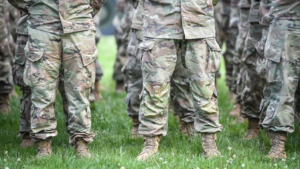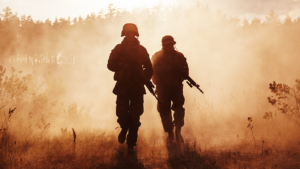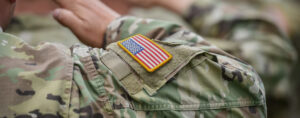
UNDERSTANDING THE DIFFERENT TYPES OF CAMO USED IN MILITARY UNIFORMS (2023)
Camouflage has always been a critical aspect of military strategy, providing soldiers with the invaluable advantage of blending seamlessly into their environments. Dating back to World War I, military camouflage has undergone substantial transformations. In the modern era, technological advancements have given rise to multiple types of camo, each designed to meet the unique requirements of different terrains and combat conditions. In this comprehensive blog post, we will explore a variety of camouflage patterns used across different branches of the U.S. military, including Space Force uniforms, Marines uniforms, and Navy uniforms.

OCP (Operational Camouflage Pattern)
The Operational Camouflage Pattern, commonly known as OCP, is prominently used across Army, Air Force, and Space Force uniforms. This versatile camouflage pattern is effective in a broad range of settings. OCP usually combines shades of green, brown, and beige, making it adaptable for forested and desert terrains.
Case Study: OCP in Afghanistan
In the rugged terrains of Afghanistan, the OCP provided U.S. soldiers with the ability to blend into mountainous and desert landscapes effectively. Its versatility makes it popular for various missions, ranging from reconnaissance to direct combat.

Multicam
Although similar to the OCP, the Multicam pattern sets itself apart through unique features such as vertical elements known as “twiglets” and some clustered areas. These design variations offer additional camouflage capabilities, notably in forested terrains. However, the U.S. military is gradually phasing out Multicam.
Case Study: Multicam in Jungle Warfare
In jungle environments, the twiglets and clustered areas of the Multicam pattern proved highly effective in providing concealment. During a special operation in South America, Multicam-clad soldiers successfully navigated dense jungles without attracting enemy attention.

MARPAT WOOD
Designed for marine uniforms, the MARPAT WOOD camouflage pattern excels in woodland settings. The digital pattern employs pixelated shapes to mimic natural settings more effectively than traditional camo patterns. The MARPAT WOOD combines shades of green, brown, and black to offer excellent concealment.
Case Study: MARPAT WOOD in Forest Operations
In a training exercise simulating woodland warfare, Marines wearing MARPAT WOOD uniforms demonstrated significantly lower detection rates compared to those in older types of camo, proving the effectiveness of the pattern in forested terrains.

MARPAT DESERT
Tailored for Marines uniforms, the MARPAT DESERT pattern focuses on desert and arid environments. This design incorporates shades of brown, beige, and light green to provide concealment. This design originated with the idea that it would be easily recognizable to its adversaries, signaling a force to be reckoned with when the enemy sees it. Serket does not make any OCIE with this pattern as of right now (Sep. 2023).
Case Study: MARPAT DESERT in Desert Warfare
During desert operations, Marines equipped with MARPAT DESERT uniforms had the upper hand in terms of concealment, effectively blending into the desert landscape and gaining a tactical advantage.

AOR II / NWU III
For Navy uniforms, the AOR II or NWU III (Working Navy Uniform) pattern remains the standard. This type of camo is optimized for maritime and tropical settings, blending shades of blue, green, and gray. The fabric is known to be reminiscent of computer pixels and has been in use since 2009.
Case Study: AOR II in Maritime Operations
In a naval exercise near the Philippines, the AOR II pattern provided sailors with excellent concealment against both the oceanic background and tropical islands, proving its effectiveness in maritime operations.

Traditional Tiger Stripe
Traditional tiger stripe camouflage is a classic pattern that has long been a staple for US Special Operations units. Its distinct dark and light stripes blend seamlessly with the jungle environment, providing effective concealment for elite forces during covert operations. Recently, we have introduced a new twist by offering a jungle tiger stripe variant in our Zephyr shirt. This addition caters to the demands of modern operatives seeking optimal concealment in dense foliage. Additionally, Serket is working on a desert tiger stripe pattern, further expanding its versatility.
Case Study: Traditional Tiger Stripe in Vietnam
Looking back at its historical significance, the tiger stripe camouflage gained prominence during the Vietnam War, where it proved exceptionally useful for American Special Forces navigating the dense Vietnamese jungles, showcasing its enduring effectiveness in challenging environments.
The Future of Camo
Research is underway to develop “smart” camouflage capable of changing its pattern and color based on the surrounding environment. While still in experimental stages, this technology could revolutionize the types of camo used in future military uniforms, offering unprecedented levels of adaptability and effectiveness. This is especially true for helping warfighters adapt to the seasons.
The Downfall of UCP Camo: Why It’s No Longer in Use
The Universal Camouflage Pattern (UCP), often colloquially known as the “pixellated” or “digital” camo, was once heralded as a one-size-fits-all solution for military camouflage. Introduced in 2004, the UCP intended to provide a versatile camouflage effective in all environments, from desert to woodland to urban settings. The U.S. Army invested heavily in this pattern, incorporating it into their Army Combat Uniform (ACU). However, within years of its introduction, it became evident that the UCP was far from the universal solution it was supposed to be.
Ineffectiveness Across Terrains
The primary drawback of UCP was its ineffectiveness across multiple terrains. While the pattern was supposed to adapt to various environments, it fell short in providing adequate concealment in almost all of them. In desert settings, the grayish color scheme made soldiers more visible rather than camouflaging them. In wooded and green terrains, the lack of green tones in the pattern made concealment nearly impossible. This ineffectiveness was not just theoretical; soldiers on the ground in places like Iraq and Afghanistan reported that the UCP did not provide adequate camouflage, thus compromising their safety.
Financial Costs
The financial repercussions of the UCP failure were also significant. The U.S. Army spent millions of dollars developing, testing, and issuing UCP-patterned uniforms and gear. Once the flaws became evident, the Army had to invest in developing and distributing a new pattern, the Operational Camouflage Pattern (OCP), which meant further financial expenditure. This shift impacted the logistics and supply chain. All garments are Berry Compliant which you can learn more about here.
Operational Setbacks
The operational setbacks were perhaps the most critical issues. Camouflage is not just a matter of uniforms but a key component of military strategy. Poor camouflage can lead to compromised missions and, in worst-case scenarios, loss of life. In theaters like Afghanistan, where warfighters used the UCP in combat situations, its drawbacks could have potentially severe consequences. Soldiers and commanders reported that the UCP was notably inferior to other available patterns in providing camouflage in various operational terrains.
Community Feedback and Soldier Morale
The community feedback, especially from soldiers who had to wear the UCP in combat situations, was overwhelmingly negative. This dissatisfaction wasn’t merely about the aesthetic appeal but more about the compromised safety and effectiveness of wearing a subpar camouflage pattern. Troop morale is a crucial factor in the success of any military operation, and the lack of confidence in the UCP had a cascading effect on the soldiers’ performance and well-being.
The Shift to More Effective Patterns
As a result of these myriad issues, the U.S. Army officially phased out the UCP in favor of the more effective OCP in 2018. The OCP addressed many of the flaws inherent in the UCP and provided a more versatile and adaptive solution suitable for multiple terrains. It not only offered better concealment but also restored the confidence of the soldiers, a non-tangible yet vital component of military efficacy.
Camouflage technology has come a long way, leading to the development of several specialized and effective types of camo. From the versatile OCP featured in Space Force uniforms to the MARPAT designs in Marines uniforms, each pattern serves a purpose. As we move into the future, continuous technological advancements promise even more effective and specialized camouflage patterns, setting the stage for new milestones in military operations.
Contact Us
To keep up to date with Serket news, fill out the contact form here, so you’ll never miss another blog. If you’d like more information on how Serket can help you with your next mission, you can send us an email at Sales@SerketUSA.com. Whatever your challenge, you can feel confident knowing Serket provides you with a uniform built for performance.
Did you hear about our recent updates to the Serket portfolio? You can read all about our new cutting-edge designs here.


